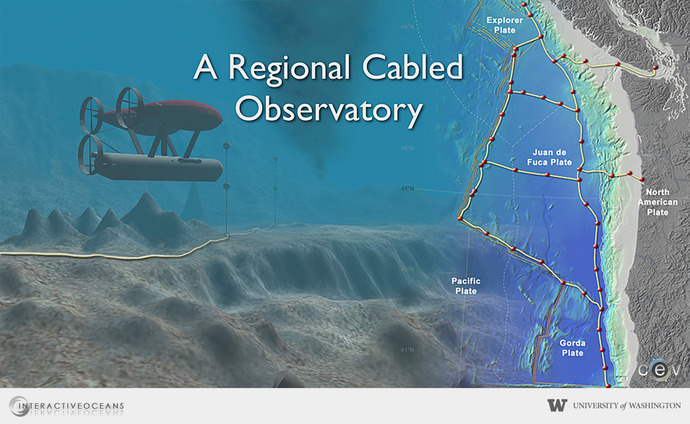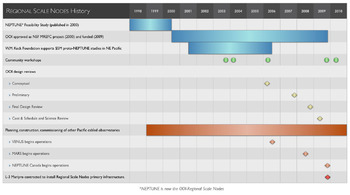High Power and High Bandwidth in the Oceans
The concept of a regional cabled ocean observatory--a system that would provide continuous high power and interactive real-time high-bandwidth data transfer to and from shore--began to be seriously explored by scientists at the University of Washington in the mid 1990s.
This vision carried with it solutions to some of oceanography’s most difficult challenges: how to study natural phenomena on time scales that range from seconds to decades and on spatial scales from microns to kilometers. The vision provided novel alternatives to science investigations based on limited and uncertain life spans of battery-powered instruments and on the vagaries of northeast Pacific storms that restrict ship-based expeditions to field seasons of only a few months each year.
Exciting exchanges between scientists and engineers led to a plan for a network of distributed sensors in the oceans attached to submarine fiber-optic/power cables connected to land. The fiber would provide continous power to interactive networked instrument arrays that would capture data and immediately send it to shore and onto the Internet. Such a system could encircle an entire tectonic plate and the ocean above it.
Feasiblity Studies
In 1998, the National Oceanographic Partnership Program (NOPP) funded the University of Washington to take the lead on a feasibility study for the program that became known as NEPTUNE—Northeast Pacific Time-Series Undersea Networked Experiments. The feasibility study design featured a cable encircling and crossing the Juan de Fuca tectonic plate, which lies off the coasts of Oregon, Washington, and British Columbia. The system would continuously collect an unprecedented diversity of coregistered information in space and time, and would respond to events—the passage of blue whales, an undersea landslide, an increase in the carbon dioxide or ocean acidity, an earthquake in the ocean crust. Thirty study sites were planned. Canada expressed interest in building the infrastructure on the northern third of the plate and also undertook a feasibility study.
In 2000, NEPTUNE feasibility studies for the U.S. and Canada were published and a multi-institutional, international partnership of institutions was established. Led by the University of Washington, members of the NEPTUNE Partnership included Woods Hole Oceanographic Institution, Canada’s Institute for Pacific Ocean Science and Technology, the University of Victoria, the Monterey Bay Aquarium Research Institute, and Caltech's Jet Propulsion Laboratory.
With a combination of U.S. and Canadian Federal, State and Provincial, and private funding, the NEPTUNE Partnership undertook development of a power system, a communications system, a proto-NEPTUNE observatory, and two shallow-water observatories—MARS in Monterey Bay, California, and VENUS off Vancouver Island, British Columbia.
The Ocean Observatories Initiative
The U.S. NEPTUNE cabled observatory effort was made part of the National Science Foundation’s Ocean Observatories Initiative (OOI), which was approved as an NSF Major Research Equipment and Facilities Construction project by the National Science Board in October 2000. NEPTUNE was eventually renamed the Regional Cabled Observatory, subsequently known as the Regional Scale Nodes within the OOI. Canada began development and construction of NEPTUNE Canada on the northern portion of the plate. Numerous science workshops in both countries garnered input from ocean science and education communities for planning experiments.
In 2005, over 175 scientists across the US responded to a Request for Assistance from the National Science Foundation to develop a cabled observatory on the Juan de Fuca Plate. From this, and with additional input from the science community, a network of focused experimental sites was developed that stretched around and across the Juan de Fuca Plate and throughout the water column covering nearshore and deep, blue-water environments 300 miles off the coast.
Current Status
The NEPTUNE Canada observatory has been installed and is operation.
The U.S. regional cabled network, or Regional Scale Nodes, component of the Ocean Observatories Initiative funded by the National Science Foundation, will be launched as two main cable segments. One segment extends approximately 300 miles from a shore station in Pacific City, Oregon westward out to the Juan de Fuca Ridge to Axial Volcano--the most robust volcano on the ridge and a site of intense hydrothermal activity. A second cable extends south and east to a major gas hydrate deposit at Hydrate Ridge and to shallow coastal sites. Each site will be densely populated with sensors and there will be four full water-column moorings on the cable. The system is scheduled to be operational in 2014.
The system is designed to be expandable over its 25-30 years of operation and the vision remains to create an observatory that, when complemented by NEPTUNE Canada, will encompass an entire tectonic plate and all the natural phenomena that occur there, whether below the seafloor, on the seafloor, in the ocean, or at the air-sea interface.







